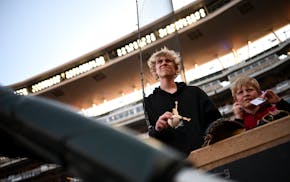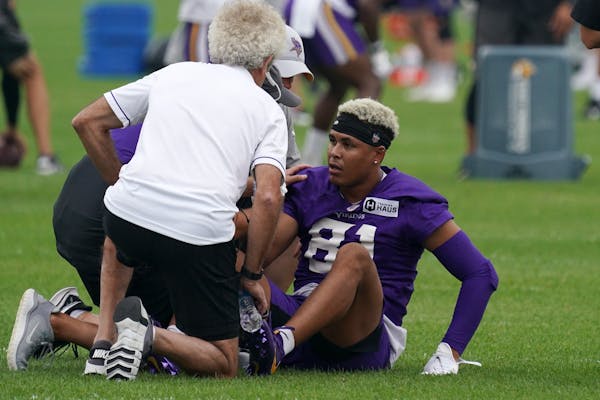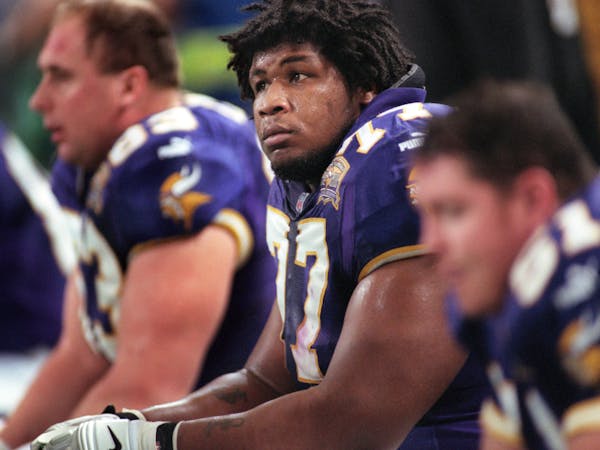Randy Moss taps his left shoulder when asked if he still thinks about his friend — that big, lovable, smiling best friend to everyone — 20 years after that tragic 12-hour turn of events in Mankato.
"Do I think of Big Korey over the years?!" the Vikings Hall of Fame receiver asked incredulously. "Every day when I look in the mirror. I got him right here on my shoulder. I've had 'Big K' tatted on my shoulder ever since the year he left us. He meant everything to me. He meant everything to us."
Korey Damont Stringer was a 6-4, 336-pound Pro Bowl right tackle, loving husband to Kelci and gushing 27-year-old father of 3-year-old Kodie when he collapsed on the practice field during training camp at Minnesota State Mankato on July 31, 2001. He died at 1:50 the next morning at Immanuel St. Joseph's-Mayo Health System hospital, suffering multiple organ failure when exertional heatstroke sent his core temperature soaring to 108.8 degrees.
"I had just left the Vikings and was in Carolina when my phone woke me up in the middle of the night," said former Vikings left tackle Todd Steussie. "It was [Vikings offensive line coach] Mike Tice. He says, 'Korey's in the hospital and there's nothing more they can do for him.' You know the NFL. I practiced the next day, but I was pretty much in a daze."
Stringer's death was "100 percent preventable," said Douglas Casa, chief executive officer of the Korey Stringer Institute (KSI), professor of kinesiology at the University of Connecticut and an exertional heatstroke survivor thanks to the incredibly fortunate forward-thinking care he received as a 16-year-old long-distance runner in 1985.
"Even before Korey's death, there was a desperate need for an institute like ours to bring about changes in the prevention and treatment of exertional heatstroke," Casa said. "It was needed before Korey's death. Unfortunately, his death was the impetus for all the changes you see today."
Also dying from exertional heatstroke within a week of Stringer were University of Florida running back Eraste Autin and Indianapolis High School lineman Travis Stowers.
"There were so many things from the day Korey died that I don't have the answers for," said Vikings Hall of Fame receiver Cris Carter. "And 20 years haven't answered them. But it changed the culture. It changed the rules because the NFL had never seen that happen before."
Awareness of the lethal danger was immediate at every level of football. The rules and protocols, as far as the NFL is concerned, took time and dogged legal battles against multiple parties by Kelci and Stringer's agent, Jimmy Gould.
"What you saw immediately after was trainers being more careful and more players standing in the IV line because they no longer felt bulletproof," Steussie said. "But all these policies about practices, two-a-days, treatment, they weren't in place for years. To do that immediately would have been an admission of guilt by the NFL. And there was no way the NFL was going to do anything official until there was some sort of resolution litigiously. I know of at least two other guys, right after Korey's death, who were put in harm's way when they shouldn't have been."
The Stringer lawsuit against the NFL didn't reach a settlement until 2009. Included was the NFL's 10-year commitment to helping fund the KSI, which has helped push the NFL, NCAA and high schools into adopting rules and protocols. The NFL's commitment continues to this day.
"A good example of change is we've gotten three-quarters of all high school practice fields in America in August to have cold-water immersion tubs," Casa said. "That would have been unheard of when Korey passed away.
"And we have tracked over 2,500 cases going back 20, 25 years in which there is a 100 percent survival rate if you get someone's temp under 104 within 30 minutes of collapse. As a result, we've gotten more than 20 states to mandate cold-water immersion tubs at high school football practices."
Stringer came into the 2001 training camp — his sixth as a 1995 first-round draft pick — in the best shape of his career.
The heat index was brutally high when camp opened July 30. Stringer vomited three times, one of which became the lead photo in the next day's Star Tribune. Stringer wasn't happy and, some say, was determined to come back strong the next day, which would be even hotter.
"I remember my ex-wife calling me early that morning thinking that practice was going to be cancelled," Carter said. "They had a livestock warning in the state of Minnesota. They advised all the farmers to put their livestock inside.
"I said, 'Hey, I train in Florida. Don't worry.' She said, 'Be careful. It's going to be a dangerous day.' It was a very, very, very, very hot day."
Stringer vomited again but made it through practice. He was putting in extra work on a stationary bag when he collapsed. Teammates were concerned, scared.
"I think back and his locker was right next to mine," Carter said. "We had lost a couple of veterans on the offensive line. Before that practice, he and I talked about his leadership expectations, the season, how much his son was growing.
"When he went down, he was right next to where the receivers were catching balls on the Jugs machine. You could see Korey working on his craft, evolving into the best version of Korey. Top to bottom on our 53-man roster, you would not have found a person who was more well-liked."
Stringer wasn't treated for exertional heatstroke — news exposed during the lawsuits. He spent 50 minutes in the team's medical trailer before being taken away by ambulance.
Saturday night, the Vikings honored Stringer's memory with a videoboard tribute and moment of silence before practicing at TCO Stadium. They also joined with the NFL Foundation and the KSI to create the Korey and Kelci Stringer Athletic Training Scholarship with an initial $50,000 endowment.
In a statement, Kelci and Gould said the scholarship will help "those who have committed themselves to seeing through our dreams and hopes of not only providing the knowledge that this is a preventable illness but also helping to save people's lives. The culture of football has and is continuing to be positively transformed."
There's still a long way to go, said Casa.
"In the last 13 months, there are six cases of heatstroke deaths in high schools, all in football," Casa said. "We need more athletic trainers, but we also need them present for all conditioning, not just August when camps open.
"This is something no one should die from. Korey Stringer would absolutely be alive today if today's protocols had been in place on July 31, 2001."
Analysis: The IndyCar season has just started but free agency is in full swing after only 2 races

Live from Target Center: Timberwolves vs. Suns game updates

Is the east side the best side in high school baseball? Poll has an answer.
Webb Simpson offers to resign from PGA Tour board. But only if McIlroy replaces him, AP source says


